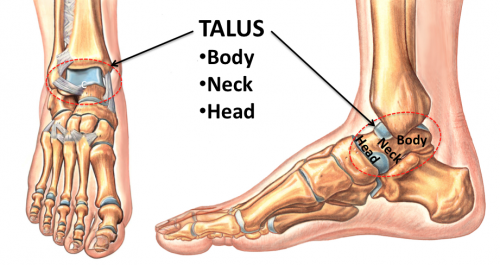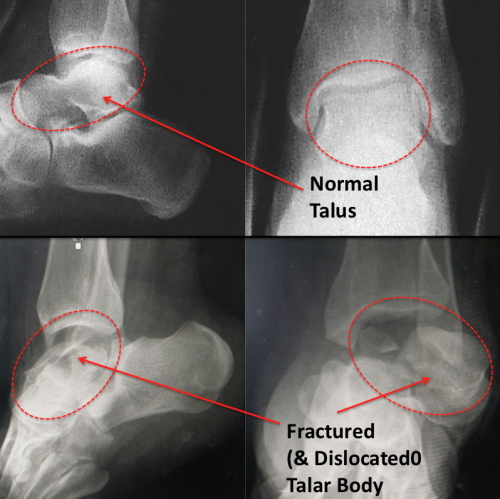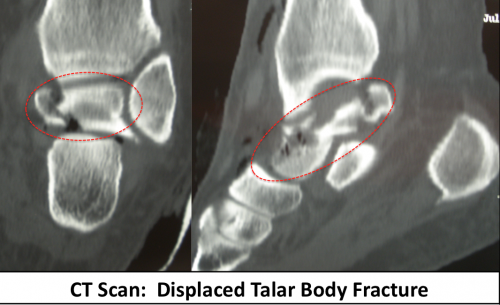Talar Body Fracture
Edited by Matthew Buchanan, MD
Summary
Talar body fractures are serious injuries to the square-like bone that makes up the lower weight-bearing bone of the ankle joint. These injuries typically occur from a major load to the ankle joint, such as what occurs following a fall from a height or following a motor vehicle crash. These fractures can be non-displaced (a hairline crack with no change to the overall shape of the bone) or displaced (the crack in the bone causes the major fragments to shift). Non-displaced or minimally displaced talar body fractures may be treated with a non-weight bearing cast. Displaced talar body fractures will often benefit from surgery to reposition the fractured bone. Both fracture types require a prolonged period of non-weight-bearing in a cast or walking boot to allow for healing (10-12 weeks). These injuries are often associated with complications or persistent problems, including a relatively high rate of post-traumatic ankle arthritis.
Clinical Presentation
The talus is the uppermost bone in your foot that joins up with the end of the shin bone (tibia) to form the ankle joint. The talus bone has a head, a neck, and a body (Figure 1). The body of the talus is the part of the talus bone that connects with the tibia and provides the “up and down” motion of the ankle joint. The talar body is shaped a bit like a square. It takes a lot of force to fracture the body of the talus (forces typically seen with major car accidents or falls from significant heights). A fracture of the talar body is a serious injury because the fracture involves the ankle joint. Patients with a talar body fracture will have a painful, swollen ankle and will be unable to bear weight on their injured extremity.
Figure 1: Talus Anatomy (Talar Body, Neck, and Head)

Imaging
This injury can often be diagnosed on plain x-rays. If the fracture is non-displaced, the x-ray findings may be subtle or even difficult to detect. In the case of significantly displaced talar body fractures, the x-ray findings can be dramatic (Figure 2). The extent of the injury is seen more clearly on a CT scan (Figure 3), an imaging modality that gives excellent bony detail. The fracture itself is often akin to a broken egg, as there are many fragments.
Figure 2: X-Rays: Normal versus Displaced Talar Body Fracture

Figure 3: CT Scan: Displaced Talar Body Fracture

Treatment
Non-operative Treatment
Occasionally talar body fractures will be non-displaced, or only minimally displaced. If this is the case, non-operative treatment is possible. Non-weight bearing in a cast or boot until the fracture has healed would be the treatment of choice for non-displaced fractures of the talar body. This often requires 8 to 12 weeks of non-weight-bearing in order to increase the chance of the fracture healing. It is often the better part of a year before the patient will reach their point of maximal improvement.
Operative Treatment (ORIF of the Talar Body)
Unfortunately, most talar body fractures are displaced. Displaced talar body fractures often benefit from surgery in an attempt to re-establish the original shape of the bone and thereby minimize the risk of long-term arthritis. The surgery is described as an open reduction and internal fixation (ORIF) of the talar body. The surgery involves one or more incisions to enter the ankle joint and reposition the broken bone fragments. These are then held in place with screws that are buried within the bone so that they do not interfere with the function of the ankle joint itself. In some instances, wires may also be used to add additional stability to the fixation. Once the bone has been put back in a better position and stabilized, the wound is then closed.
Recovery
Recovery from surgery requires prolonged non-weight bearing (usually 10 to 12 weeks) in a cast or cam boot to allow for adequate bone healing. Physical therapy may be necessary to improve strength and maximize flexibility.
Potential Complications
Specific Complications of Talar Body ORIF
Complications that are specific to this injury include:
- Delayed or nonunion of the fractures. The talus bone (and specifically the talar body) has very poor blood supply, and it is not uncommon for some or all the fracture fragments to heal slowly or fail to heal at all due to the blood supply. This risk will be increased in smokers.
- Long Term Ankle Arthritis. The body of the talus is the main bone in the lower part of the ankle, and as such it is a critical part of the ankle joint. A talar body fracture is a significant injury to the ankle joint and will often result in some ankle arthritis that may in some instances be severe. Even fractures that are perfectly positioned can have significant cartilage damage with resulting ankle arthritis. This can be akin to a hard-boiled egg that is dropped and cracks. Even though the egg maintains its shape, there is still some damage to the outer surface.
- Nerve Injury. There are sensory nerves in this area that may be damaged either directly or with traction in the course of approaching the fractured bone. These nerve injuries can lead to temporary or permanent sensation loss over certain areas of the foot and/or burning type pain into the foot.
- Osteotomy Non-union. In order to surgically fix a talar body fracture, it may be necessary to make a controlled cut (osteotomy) of one of the ankle bones to allow visualization of the broken pieces. For example, the prominent bone on the inside of the ankle (medial malleolus) is often cut in order to provide better exposure to the injury site. At the conclusion of the surgical fixation of the talar body, this bone would then be stabilized with screws. In some patients this osteotomy may not heal, creating a painful nonunion that may delay the recovery or require further surgery.
- Painful Hardware. Occasionally, there will be hardware that becomes prominent either inside the ankle joint or perhaps in the controlled bone cut (osteotomy) used to expose the area. If this is the case, it may be necessary to remove this hardware with surgery.
General Potential Complications
This is an injury that can be associated with:
Edited July 31, 2017
mf/ 11.6.19